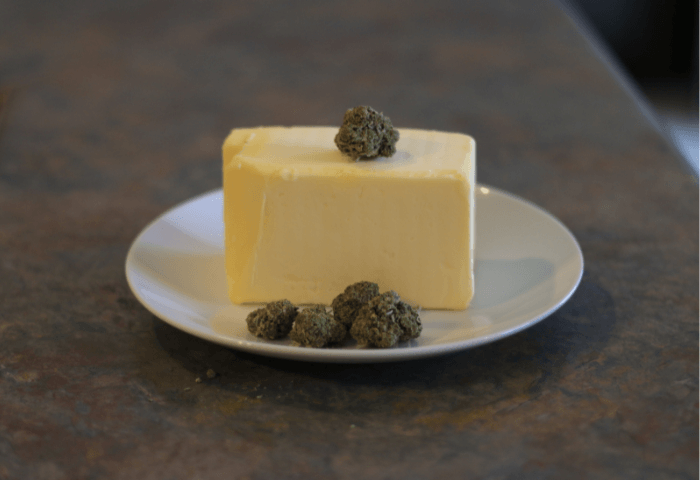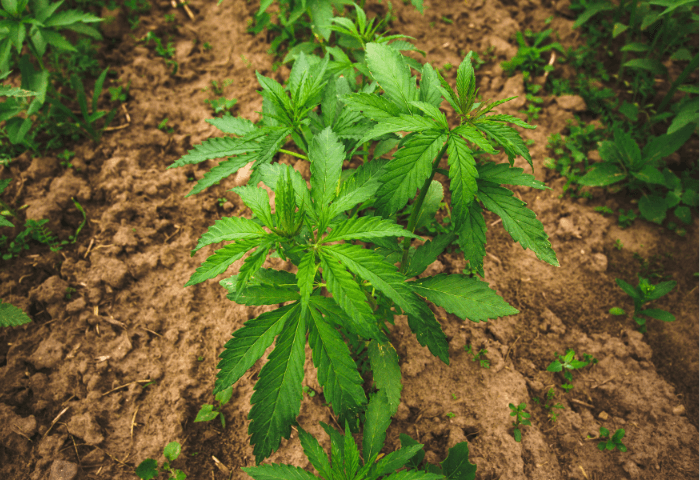In a world where cannabis-infused cuisine is becoming increasingly popular, mastering the art of making the perfect cannabutter is essential for any cannabis enthusiast.
The secret to unlocking the tastiest and most potent edibles lies in the alchemy of transforming ordinary butter into a magical, lip-smacking ingredient that will elevate one’s culinary creations to unparalleled heights.
In this comprehensive guide, the reader will find step-by-step instructions for creating the most delectable and versatile cannabutter, from choosing the right cannabis strain to determining the perfect dosage for their needs.
With the right ingredients and equipment in hand, it’s time to embark on a delightful journey into the world of cannabutter!
Step 1: Decarboxylation – Activating Your Cannabis
Decarboxylation is crucial for making the most POTENT cannabutter, activating key cannabinoids like THC and CBD, which provide psychoactive and therapeutic effects [1].
Raw cannabis contains inactive precursors, THCA and CBDA, which lack the desired effects when consumed.
Decarboxylation unlocks the FULL POTENTIAL of cannabis in edibles. This process heats the cannabis at a specific temperature and duration, releasing a carboxyl group from THCA and CBDA molecules and converting them into active THC and CBD.
Decarboxylating before infusion ensures users experience the full benefits of cannabis; skipping this step results in weaker, less enjoyable cannabis-infused butter(and nobody wants that!).
What You’ll Need
- Cannabis flower
- Baking sheet
- Parchment paper
- Grinder/scissors
- Oven
- Thermometer (optional)
- Timer
- Gloves/oven mitts
- Airtight container
Step By Step Instructions For Decarboxylation
- Preheat oven: Set it to 240°F (115°C) to preheat your oven. If you’re unsure about your oven’s temperature precision, double-check it using an oven thermometer.
- Prepare cannabis: To prepare the cannabis flowers, use a grinder or scissors to break it down into small, evenly-sized pieces. Be careful not to grind it too finely, as this may cause over-decarboxylation.
- Line baking sheet: Cover the entire surface of the baking sheet by placing parchment paper on it.
- Spread cannabis: Spread the ground cannabis evenly on the baking sheet lined with parchment paper. Try to avoid any clumps to ensure that it heats up evenly.
- Bake cannabis: To bake your cannabis, put the baking sheet in the oven and set the timer for 30-45 minutes, depending on your preference and the type of cannabis material used. If you’re using buds, a shorter time is usually sufficient, while trim and shake may require longer.
- Check and stir: To ensure the heat is evenly distributed, stir the cannabis with a spatula every 10-15 minutes. Remember to be careful when opening the oven, as the vapor released can be strong.
- Monitor color: During the decarboxylation process, the color of cannabis should change from bright green to a golden brown. This color change indicates that decarboxylation is finished.
- Remove from oven: When the cannabis has turned the color you want, use heat-resistant gloves or oven mitts to remove the baking sheet.
- Cool down: Let the decarboxylated cannabis cool down entirely on the baking sheet before moving on to the next step. This is necessary to prevent burns or harm to the cannabinoids.
- Store or use: After cooling down the decarboxylated cannabis, you can store it in an airtight container or sealable plastic bag. Alternatively, you can use it in your cannabutter recipe.
Step 2: Making Weed Butter
To make cannabis edibles, the CRUCIAL step is to make cannabutter which involves infusing cannabis cannabinoids with butter. This creates a potent and tasty ingredient that can be utilized in various recipes.

What You’ll Need
- Butter (8 ounces or 1 cup)
- Water (2 cups)
- Decarbed cannabis (1/4–1/2 ounce)
- Stovetop pot or slow cooker
- Cheesecloth
- Large bowl
- Container for storing
Step By Step Instructions For Making Cannabis Butter
- Prepare ingredients: Measure out the following quantities:
- 1 cup (8 ounces) unsalted butter
- 2 cups water
- 1/4 to 1/2 ounce decarboxylated cannabis
- Combine butter, water, and cannabis: In a stovetop pot or slow cooker, combine the melted butter, water, and decarboxylated cannabis.
- Heat mixture: If using a stovetop pot, maintain a low heat (around 160-200°F or 70-95°C), and let the mixture simmer for 2-3 hours. If using a slow cooker, set it to low heat and let the mixture cook for 4-6 hours. Stir occasionally to ensure even distribution and prevent scorching.
- Strain mixture: Place a cheesecloth over a large bowl, ensuring it covers the entire opening. Slowly pour the butter mixture through the cheesecloth to separate the cannabis plant material from the infused butter. Gently squeeze the remaining liquid out of the cheesecloth, but be careful not to apply too much pressure, as this may cause unwanted plant material to pass through.
- Cool and separate: Allow the strained butter mixture to cool at room temperature for about 30 minutes, then transfer it to the refrigerator for a few hours or overnight. The infused butter will solidify and separate from the water, forming a solid layer.
- Remove the butter layer: Once the infused butter has fully solidified, carefully remove it from the water using a knife or spatula, and discard the remaining water.
- Store cannabutter: Place it in an airtight container and store it in the refrigerator or freezer until ready for use. Use it in your favorite recipes as a substitute for regular butter to enjoy cannabis-infused edibles.
Pro Tip: Whilst full-fat butter is usually used, you can replace this with coconut oil, olive oil, or ghee.
Choosing the Right Cannabis
Strain Considerations (Indica, Sativa, Hybrid)
When choosing the ideal cannabis for cannabutter, consider the STRAIN TYPE [2]. Indica strains provide relaxing, sedative effects, great for “Netflix and chill.”
Sativa strains offer unparalleled UPLIFTING, energizing properties, transforming consumers into social butterflies (or chatty couch potatoes).
Hybrids combine indica and Sativa traits, delivering versatility for a tailored experience. The strain choice depends on the DESIRED edible effects, whether ultimate relaxation, unmatched creativity, or highly effective pain relief.

THC and CBD Content
It’s essential to consider the THC and CBD content in the cannabis you choose.
THC is the psychoactive compound responsible for the “high” associated with cannabis, while CBD is non-psychoactive and offers many therapeutic BENEFITS (think of it as cannabis’ responsible sibling).
Depending on your preferences, you may want a high-THC strain for the most potent effects, a high-CBD strain for unparalleled therapeutic purposes, or a BALANCED THC-to-CBD ratio for a more well-rounded, harmonious experience.
Sourcing Quality Cannabis
To ensure the most scrumptious results and maintain SAFTEY, it’s crucial to use top-notch cannabis for your homemade edibles.
Sourcing from a reputable dispensary or LICENSED producer guarantees the cannabis is tested for potency and free of unwelcome guests (such as pesticides, mold, and heavy metals).
If you’re growing your own cannabis, ensure that you follow proper CULTIVATION practices and test your harvest to maintain the highest quality and safety standards.
Using exceptional cannabis will not only IMPROVE the taste and effects of your edibles but also safeguard your health (and your taste buds).
Dosage and Usage Tips
Determining your cannabutter’s potency is ESSENTIAL for a safe and enjoyable experience with edibles. Consider the THC and CBD content of your cannabis and the butter-to-cannabis ratio in your recipe. Online calculators can help estimate potency (no math degree required!).
When trying cannabutter edibles, start with a LOW DOSE to avoid discomfort, especially for cannabis newcomers. Begin with a small portion and wait one to two hours before consuming more, as edibles take longer to take effect.
Adjust the dosage accordingly as you become familiar with your cannabutter’s potency and TOLERANCE. Remember, everyone’s cannabis experience is unique.
Cannabutter offers a world of exceptional culinary opportunities, from sweet treats like brownies to savory dishes like pasta. Experiment with various RECIPIES and savor the delectable flavors your homemade cannabutter adds to your meals.
Conclusion
Creating cannabutter can be an enjoyable and straightforward process that presents numerous culinary opportunities.
By selecting the proper strain and ensuring the cannabis is of good quality, you can use your homemade butter to make delectable edibles and embark on a remarkable culinary adventure.
If you want to make delicious edibles using cannabis, cannabutter is a great choice, whether you’re seeking therapeutic benefits or just want to have some culinary fun. Remember to start with a low dosage and increase slowly.
Sources –
- Decarboxylation guide: How to properly decarb weed. Leafly. Published July 26, 2022. Accessed April 8, 2023. https://www.leafly.com/learn/consume/edibles/what-is-decarboxylation
- Holland K. Sativa vs. Indica: What to Expect Across Cannabis Types and Strains. Healthline. Published March 21, 2021. Accessed April 8, 2023. https://www.healthline.com/health/sativa-vs-indica
